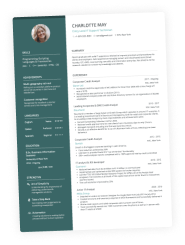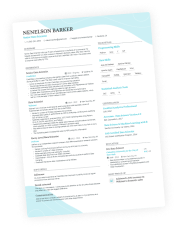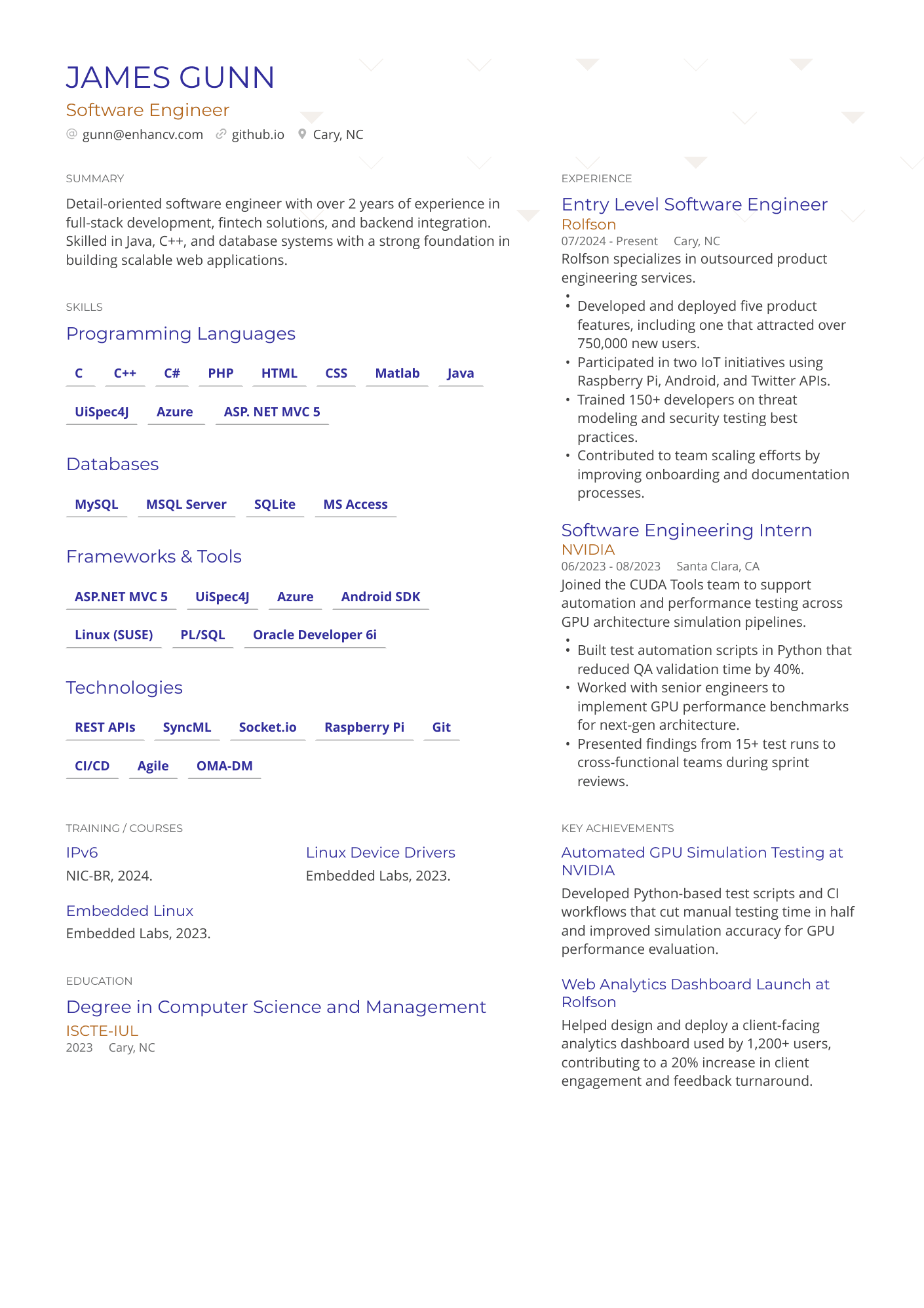You’ve completed an internship—now you’re wondering how to list it on your resume in a way that supports your job application success. It’s not just about formatting. It’s about showing the value of that experience: the skills you built, the responsibilities you handled, and how it all adds to your career readiness.
An internship is not merely a resume filler, but a testament to your hands-on contributions and professional growth.
Enhancv’s Resume Builder helps you turn that experience into a compelling story—so it does what it should: move your career forward.
Key takeaways
- Internships can strongly enhance your resume: When written with intention, they demonstrate career readiness, initiative, and practical experience.
- Not every internship belongs on your resume: Prioritize recent, relevant roles that align with the job you’re applying for.
- Where you place an internship depends on your career stage: Work Experience is common, but a separate section or mention in your summary can be equally effective in certain cases.
- How you format your internship matters: Use clear titles, quantifiable achievements, and ATS-friendly structure.
- Enhancv’s AI-powered Resume Builder helps you turn your internship into a compelling, well-organized entry: It helps you optimize your phrasing and format suggestions.
Still preparing to land your first internship? Explore our Intern Resume Examples for tailored templates and inspiration to help you get noticed from the start.
What is an internship for a resume?
An internship—sometimes called a student placement, pre-professional role, or on-the-job training—is a short-term opportunity to gain real-world insight into a specific field. On a resume, an internship can serve as a meaningful bridge between your education and full-time work. The key is to frame it intentionally, prioritizing the skills and experiences most relevant to the roles you’re applying for.
Internships can be full-time or part-time, paid or unpaid, remote or in-person. But regardless of format, they’re designed to offer practical training, skill development, and exposure to professional environments.
Employers see internships as a sign of initiative and career focus—especially when they include hands-on contributions, mentorship, and quantified results tied to real work.
What an internship really adds to your resume
When written thoughtfully, internships can do more than just fill space. They can demonstrate career readiness, initiative, and relevant experience.
Why internships matter
- They count as professional experience: Even if the role was unpaid or short-term, on-the-job training often involves real responsibilities, team collaboration, and contributions to outcomes. When presented well, they belong in your work experience section.
- They showcase both technical and soft skills: Internships let you build job-specific abilities (like using industry tools or running reports) while also developing soft skills like communication, problem-solving, and time management.
- They reflect alignment with job descriptions: A well-written internship entry can echo keywords and skills listed in job postings—boosting your chances with both hiring managers and applicant tracking systems (ATS).
- They demonstrate initiative and career focus: Choosing to spend time gaining on-the-job training shows future employers that you’re serious about your field and proactive in building your expertise.
- They support career transitions: For career changers or students, internships provide foundational experience and networking opportunities in a new field—proof that you’ve already taken meaningful steps toward the career you’re aiming for.
Enhancv’s AI Resume Builder helps internships shine on your resume by suggesting role-specific phrasing, optimizing structure for impact, and ensuring the experience reads like real, credible work—because it is.
Should you include your internship on a resume?
Not every internship belongs on your resume—but when it does, it can seriously elevate your profile.
Here’s how to decide:
List your internship if:
- It’s directly related to the job you're applying for: Recruiters will see clear relevance, especially if you highlight aligned competencies and tools.
- You’re a recent graduate or still studying: Internships often stand in for direct experience and show you're career-ready.
- You’re changing careers: They signal relevant exposure to your new field—even if it wasn’t full-time.
- You don’t have much industry know-how yet: Every bit of hands-on, structured work adds credibility to your application.
Leave it off if:
- You have more than five years of full-time experience: If your recent roles are directly related to the job you're targeting, older internships may no longer add meaningful value to your resume.
- The internship is unrelated to your current goals: If it doesn't strengthen your overarching career narrative, omit it.
- It’s outdated: Generally, internships from more than five to seven years ago often feel irrelevant—unless they're uniquely impressive or field-specific (e.g. top-tier companies like Google or UN, research, or niche industries).
Once you’ve decided your internship deserves a spot on your resume, the next question is where it fits best. Should it go under Work Experience, or does it need its own section? That depends on your career stage, how many internships you’ve done, and how closely they relate to the jobs you’re applying for.
Where to put internships on your resume to make them count
So, the next step is choosing where an internship belongs on your resume. Where would it make the most impact?
Here’s how to determine the best placement based on your experience and resume format:
The work experience section (most common)
If your internship gave you meaningful, hands-on experience—whether you supported real projects, interacted with clients, or used job-specific tools—it belongs in your main work experience section.
Treat it like any other role and include:
- Your job title (e.g. Marketing Intern, UX Research Intern)
- Dates of employment
- Company name and location
- Three to five bullet points showcasing your impact, tools used, or results achieved
This placement is most logical if your internship is recent, directly relevant to the role you're applying for, and reflects the kind of responsibilities you’d have in a full-time position. It’s especially useful for students, recent graduates, or career changers who want to show credible experience in the field.
Let’s look at how this plays out in a real example of an internship entry from an aspiring investment banker:
- •Conducted financial modeling and valuation analyses (DCF, LBO, comparable company analysis) on potential acquisition targets and client portfolios.
- •Supported the execution of a $1.4B merger deal by preparing pitch materials, industry research, and due diligence summaries for senior bankers.
- •Built market comps and transaction databases used in pitch books presented to top-tier clients across banking and insurance sectors.
- •Collaborated with analysts and associates to review S-1 filings and IPO readiness documentation for a regional bank IPO.
A separate internships section
In some cases, it makes more sense to break internships out into their own section—especially when they form the core of your relevant experience but don’t quite sit comfortably alongside full-time roles.
This option works well if:
- You’ve completed multiple internships across different roles or companies.
- Your internships are the most relevant part of your background, even if they weren’t full-time positions.
- You want to keep them separate from other work experience—for example, if you’re pivoting careers or returning to the workforce after a break.
Even though you're separating them, list your internships just like any other job—include your title, company, location, dates, and bullet points with quantified achievements. The only difference is the section heading. Calling it Internship Experience or Relevant Internships signals that this phase of your career was (or still is) more substantial than your traditional work history.
Below is a resume excerpt from a STEM graduate with no full-time roles yet, but two strong internships—one in a corporate data setting, and another in academic research.
- •Developed interactive dashboards using Python and Tableau to streamline quarterly reporting workflows.
- •Cleaned and analyzed customer usage datasets with Pandas, contributing to a 12% efficiency increase in internal forecasts.
- •Collaborated with cross-functional teams to integrate new machine learning metrics into business performance models.
- •Built Python scripts for analyzing spike train data from multi-electrode arrays.
- •Conducted statistical validation on model outputs using NumPy and SciPy libraries.
- •Co-authored a research abstract presented at the Society for Neuroscience 2022 conference.
This example:
- Shows a clear technical foundation.
- Differentiates between academic and corporate experience.
- Emphasizes relevant tools and quantifiable contributions.
- Makes perfect sense as its own section for a student with no full-time roles yet.
Other situations where a dedicated internship section is okay:
- You’ve completed multiple internships across different companies or roles and want to underline a consistent pattern of growth or interest in one field.
- You’re pivoting into a new industry, and your internships are more relevant than your past full-time roles.
- You’re returning to work after a career break, and internships helped you rebuild experience and confidence.
- You’re an international student with multiple internships across countries and need to show how they connect to your target market.
- You’ve done research or lab-based internships that align closely with the field you’re entering, even if they weren’t part of formal employment.
The resume summary or objective section
If your internship is the most relevant or impressive part of your background, it deserves a mention right at the top of your resume.
Your summary or objective is your chance to frame your story in a sentence or two. Including an internship here can help clarify your experience, signal career focus, and show early traction in your field.
This works especially well when:
- You’re applying for your first full-time role, and your internship gave you hands-on experience in the same field.
- You pivoted into a new field and want to highlight relevant exposure from the start.
- Your internship was with a well-known organization or tied to an impactful project.
To build a strong summary or objective statement, focus on what you did during the internship, what skills you gained, and how that experience connects to the job you’re applying for. Keep it concise—up to three lines is enough to show relevance and intent right at the top of your resume.
Here’s an example:
More often than not, a resume objective is more suitable than a summary. Objectives are especially useful for students, recent graduates, or career changers—people who may not have extensive work history but want to show how their skill set can contribute to a specific company or role. An objective statement allows you to speak directly to your goals and the value you’re ready to bring.
The education section
If your internship was part of your academic program—like a capstone, practicum, or co-op—it can be listed under your education section. This keeps your resume clean and focused, especially if you’re early in your career and want to highlight where your experience came from.
You might also use this approach if the internship was short-term, unpaid, or supplemental to your main experience.
Here’s how to describe an internship when woven into the education section:
- Start with your degree.
- Add the name of the institution.
- Include the location (city and state) and your graduation year or expected graduation date.
- List the internship as a sub-entry. Use a label like Related Internship followed by your role, the organization, and the timeframe).
- Add two to three bullet points describing your contributions, skills used, or results achieved during the internship.
Like so:
- •Related Internship: Content Marketing Intern, HubSpot (Spring 2023)
- •Created and edited blog content optimized for SEO; 3 articles published under editorial review.
- •Used HubSpot analytics tools to evaluate post performance and adjust content strategy.
- •Supported social media calendar scheduling across LinkedIn and Twitter.
Bonus: How to position internships across resume formats
Once you’ve chosen the right section, it’s equally important to position your internships in a way that feels consistent and natural—whether you’re writing a traditional resume or something more skills-based.
The rule of thumb is to list all roles—full-time or pre-professional—in reverse chronological order. Put your most recent position first and work backward from there. If you're mixing internships with jobs, resist the urge to reorder them to fill gaps—let the timeline speak for itself.
This determines the flow of the reverse chronological resume, which both recruiters and ATS prefer for its straightforward, scannable structure.
See how a junior data analyst demonstrates career growth by listing a small but highly relevant set of experiences—starting with the most recent role and including an internship.
However, there are two other resume formats that may be a better fit depending on your career path: the combination and functional formats.
Unlike the reverse chronological structure—which prioritizes your work history by date—both of these place greater emphasis on your skills and core competencies. As a result, your experience section (including internships) typically appears further down the page.
If you're using a combination (or hybrid) format, you’ll lead with a summary of your key skills followed by a chronological work history. This works well if you want to show how your internships developed specific abilities that match the job you're applying for.
Here’s how this can look for a software engineer:
In a skills-based (functional) resume, the focus shifts almost entirely to transferable skills, with work experience often grouped under themed sections like Relevant Experience or Projects & Experience. This format is especially helpful if you're changing careers or your most applicable experience—like internships—wasn’t gained through traditional full-time roles.
Below is an example of a marketing internship on a resume:
Once you’ve decided to include an internship and figured out where it fits, the next step is getting the formatting right.
How to format internships on your resume
How you present your experience matters just as much as what you say. Hiring managers (and ATS) scan for structure, clarity, and impact—so give your internship the same professional treatment you’d give any job.
Here’s how to do it:
- Title the role clearly: Use a specific title like Marketing Intern or Software Engineering Intern—not just Intern.
- List the basics: Company name, location (remote or on-site), and start and end dates.
- Add bullet points that clearly describe what you did and achieved—tailoring your language to match the job description whenever possible.
More tips to make your internship stand out
- Start with action words: Use strong verbs like analyzed, coordinated, launched, or designed. Vague phrasing like helped with or worked on won’t impress.
- Include metrics or results whenever you can: Quantifying your impact is the fastest way to make your contributions feel real and credible to a recruiter.
- Align your bullets with the job you’re applying for: Focus on responsibilities and outcomes that directly connect to the role. It helps both humans and ATS see the match instantly.
Of course, some things can raise red flags with hiring managers—and often, it’s not the internship itself, but how your resume is formatted. Your best move is to stick with simple, ATS-friendly templates, clean fonts, and minimal use of graphics.
AI scanners perform best with resumes that follow a standard structure. Creative visuals, tables, or charts might look great to the eye but can confuse applicant tracking systems. If you want your internship to stand out, skip the design tricks and focus on the results.
Here are a few more faux pas to consider:
Mistakes to avoid when listing internships
- Using generic titles: Simply writing Intern doesn’t tell the reader much. Be specific—use a title and headline that reflect the role and align with the job you’re targeting.
- Leaving out details: Don’t just list the company and dates. A few bullet points highlighting your contributions will give your internship real weight.
- Overusing vague language: Phrases like assisted with or supported feel passive. Show what you owned, built, improved, or delivered. Use descriptive language to reflect your initiative.
- Skipping results: A bullet without context or outcomes won’t stand out. Even simple metrics—like reach, growth, or engagement—can help prove your impact.
- Forgetting to tailor: Reusing the same descriptions for every application misses the mark. Adjust your wording to reflect the job posting and make your relevance obvious.
A simple template for formatting an internship on your resume
If you’re building your resume in MS Word or Google Docs, here’s an easy structure you can copy and adapt. It works well with any clean, ATS-friendly layout.
Just make sure to tailor the wording to fit the job you’re applying for—and focus on what makes your internship experience relevant.
[Your Internship Title]
[Company Name], [City, State]
[Start Date] – [End Date]
- Bullet point 1: Start with a strong action verb. Describe what you did or contributed.
- Bullet point 2: Include any tools, processes, or methods you used.
- Bullet point 3: Highlight results or outcomes. Add metrics if possible (growth %, engagement, time saved, revenue impact, etc.).
- (Optional) Bullet point 4: Mention collaboration or cross-functional work, if relevant.
Most prestigious internships
According to Vault's 2026 Internship Rankings, NASA's OSTEM Internship Program has been named the Most Prestigious Internship for the fourth consecutive year. Interns describe it as "the most desired STEM internship" and highlight the invaluable experience and early career clout it provides.
Other top-ranked programs include internships at Google, Apple, and Goldman Sachs, all renowned for offering meaningful work and significant networking opportunities.
Frequently asked questions on internships on resumes
Still wondering about a few edge cases or details? Here are quick answers to some of the most common questions job seekers have about adding internships to their resumes.
How do you list a current internship on a resume?
List it in your experience section with the start date and “Present” as the end date (e.g., June 2024 – Present). Write your bullet points in present tense to reflect that the role is ongoing.
How do you list an upcoming internship on a resume?
You can include it, but be clear that it’s a future role. In the date line, write Start date: Month, Year (Incoming) or Planned for Summer 2026. That said, it’s often better to mention the upcoming internship as a brief one-liner in your resume summary or objective instead—this way, you won’t take valuable space away from roles or projects you’ve already completed.
Is “Intern” a job title?
It’s better to be specific. Use a clear title that reflects your role and field, such as HR Intern, Data Engineering Intern, or UX Design Intern. This helps both ATS and hiring managers quickly understand the nature of your experience.
How do you list multiple internships on a resume?
If they’re in the same field or show a clear progression, list them separately in your Work Experience section in reverse chronological order. If they’re short-term or across different industries, consider grouping them under a dedicated Internship Experience or [Name of Industry] Experience section.
Does a remote internship count on a resume?
Absolutely. Remote internships are just as valid as in-person ones—especially now that many companies operate in hybrid or fully remote models. Just indicate that the role was remote in the location line (e.g., Remote) and focus on the outcomes and tech skills you gained.
PRO TIP
If you completed a remote internship, it’s a great idea to highlight any remote collaboration tools or platforms you’re comfortable with (think: Slack, Zoom, Asana, Trello, Google Workspace). These skills signal that you can thrive in a distributed work environment—something many employers value highly today.
Conclusion
Internships can be a powerful part of your resume if you present them the right way. Whether you choose to spotlight yours in your work experience section, as part of your education, or in a dedicated area, the goal is the same: to show the value of the work you’ve done and how it prepares you for what’s next. With the right structure and wording, your internship can help open doors.
Make one that's truly you.






